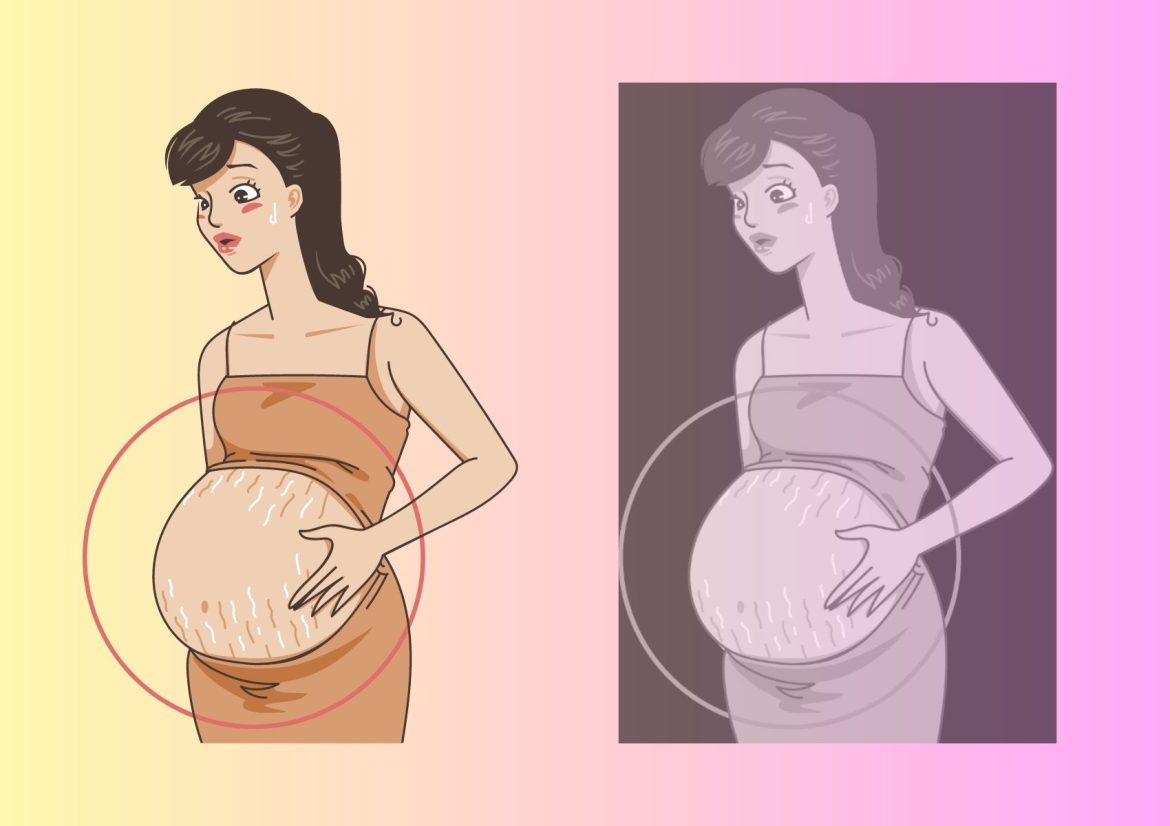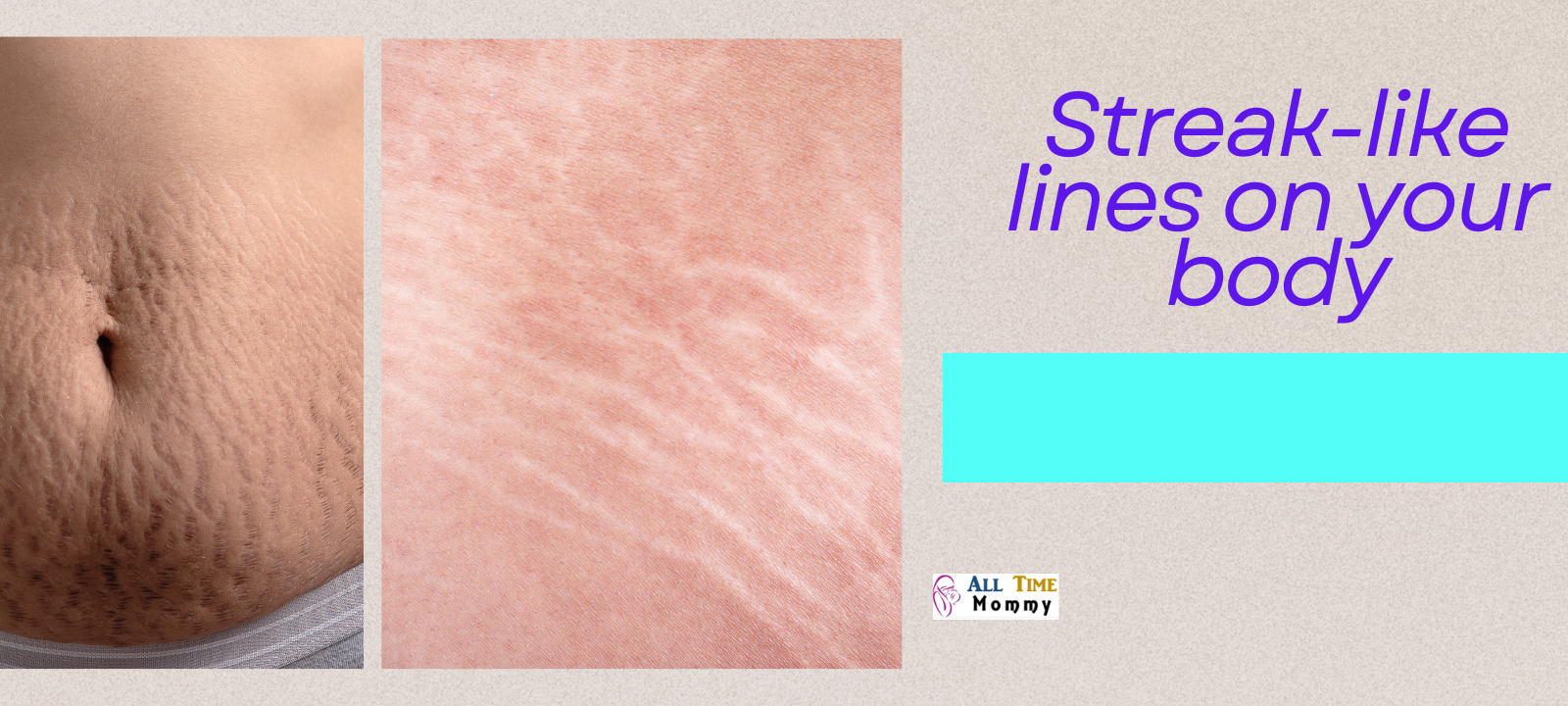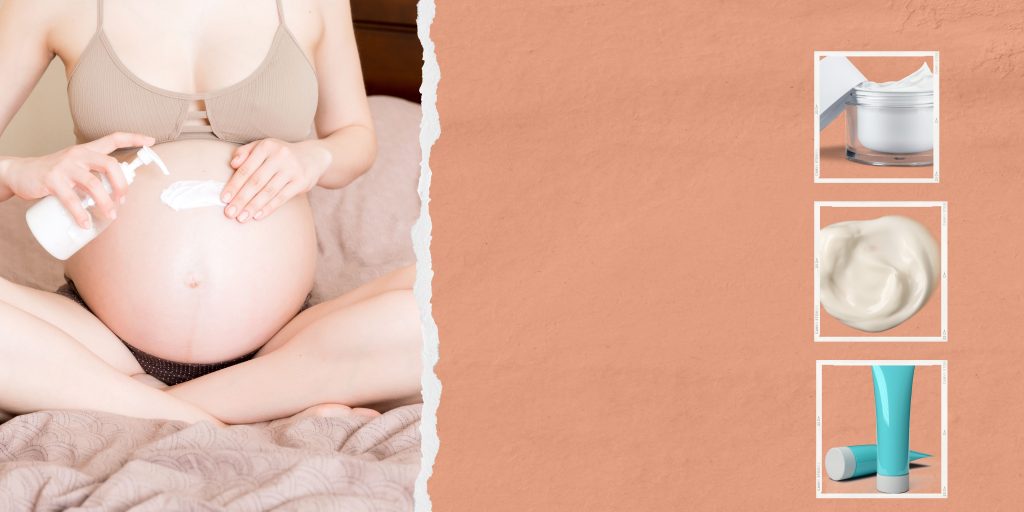Pregnancy is a joyous and beautiful experience. But it can come with unexpected changes to your body. One of pregnancy’s most common side effects is pregnancy stretch marks.
pregnancy stretch marks mainly affect the abdomen, breasts, hips, and buttocks.
Many women feel embarrassed or concerned about the appearance of stretch marks during and after pregnancy. But there are ways to help manage and reduce their visibility.
In this post, we’ll look closer at pregnancy stretch marks and discuss techniques for reducing their appearance.
But before we jump into remedies, let’s have an overview about pregnancy stretch marks.
What are Pregnancy Stretch Marks?
Pregnancy Stretch marks are narrow, streak-like lines that develop on the surface of the skin of pregnant moms.
According to the American Academy of Dermatologists, these streaks–like lines affect about 8 out of 10 pregnant women. Depending on your skin color, they usually appear as pink, red, purple, or brown.
In pregnancy, Stretch marks usually appear on the tummy. However, it can also appear on your upper thighs, arms, around your waist, ankles, and breasts.
What Do Pregnancy Stretch Marks Look Like?
Pregnancy stretch marks manifest as Streak-like lines on your body. Here’s how they look like.
Causes of Pregnancy Stretch Marks
Stretch marks may appear whenever the middle layer of skin is stretched beyond the tensile limit.
Scientifically, the stretch on your skin may happen when your connective skin tissues like collagen and elastin stretch to a maximum point during periods of rapid growth.
This rapid growth typically occurs during pregnancy, weight gain, or increased muscle mass.
And not just that.
When the skin returns to its normal state like after childbirth, you may look lined and “wrinkled”.
This new look comes about because your skin is not supported by the usual collagen structure underneath.
The degree of stretching usually varies with the individual.
Your skin will stretch depending on skin type and genetic factors. Some women may experience severe skin stretching, while others get a few stretch marks.
What Causes Pregnancy Stretch Marks?
Various factors cause pregnancy stretch marks. these include;
Hormonal changes: during pregnancy, there is a disruption of hormonal balance that can affect collagen production. Also, the production of the hormone cortisol may affect your skin’s elastic fiber making it prone to stretch marks.
Your skin type: some skin types are more elastic than others. For instance, dry skin is less flexible than well-hydrated skin. If your skin is moisturized, you are less likely to develop stretch marks. And if they occur, they may be less severe than those with dry skin.
Genes; some genes may also expose you to pregnancy stretch marks. If you have a family history of pregnancy-related stretch marks, you can be at a higher risk of developing some.
Age: according to the American Academy of Dermatology, young people are at a higher risk of developing pregnancy stretch marks. This is because their skin contains more collagen. They also have better skin-supportive tissues that are pretty rigid in stretching. Fortunately, these young skin also heal stretch marks faster.
Pregnancy weight gain: As your tummy expands during pregnancy, your body may be subjected to stretches. This happens to accommodate the growing fetus. Consequently, the stretch marks may be more severe if your weight gain is rapid and more than average (about 10 to 12.5kg (22 to 28lb).
Which Month of Pregnancy Do Stretch Marks Appear?
Most women tend to get Stretch marks at the end of the second trimester. This is about your sixth and seventh month when the fetus grows rapidly in the womb.
Around this period, you’ll experience tummy itchiness and dryness. Also you may notice pinkish streaks around your stomach, breasts, thighs and calves.
Be sure to apply a moisturizer and maintain hydration to reduce the severity of your skin breakout.
How Do You Prevent Pregnancy Stretch Marks?
As a mom who has dealt with pregnancy stretch marks, I can’t promise any magic. However I believe there are things you can do to help prevent the severity of stretch marks appearances on your body as you wait for a more permanent solution.
Here is my take.
You can use two primary strategies to address the stretch mark issues.
- Preventing the development through the inside job approach
- Reducing the severity of pregnancy stretch marks
The inside job
1. Boast your collagen production
Collagen is crucial for skin, joints, hair, and bone support. During pregnancy, collagen is vital for skin elasticity and stretching.
And not just that.
One study shows that collagen is also essential for your fetus’s survival and development.
It also helps with joint pains and prepares your body for a quick postpartum recovery through skin cell renewal and repair.
When collagen levels are low, you may experience skin issues, including a loss of elasticity in the skin and other connective tissues.
Collagen and Skin Elasticity
Is there scientific evidence showing the relationship between collagen and skin elasticity in women?
well, mama
According to a study, Supplementing with collagen during pregnancy can improve the elasticity in your skin. This help reduce the severity of stretch marks, fine lines, and wrinkles.
So,
How Does Collagen Reduce Pregnancy Stretch Marks?
Boosting your body’s “collagen stores” through collagen supplementation can help your skin better withstand stretching.
With better skin elasticity, you stand a chance of preventing stretch marks from occurring.
Collagen supplements can boost collagen production in your skin. This helps reduce the appearance of pregnancy stretch marks.
Worthy noting, however, is that it’s easier to remove recently developed stretch marks than older ones.
And here is the reason.
Stretch marks often begin as red or pink, depending on your skin color. These are often referred to as (striae rubra) because blood vessels are present under the skin.
These functioning blood vessels may help transport the collagen peptides to the scar sites. This will stimulate further collagen synthesis resulting in healthy-looking skin.
On the other hand,
Older stretch marks appear white (stria alba) because the underlying blood vessels have narrowed. This limits the transportation of collagen peptides, including other essential nutrients necessary for skin healing.
That is why the timely consumption of food or supplements supporting collagen production is crucial.
What Foods Boost Collagen During Pregnancy?
Collagen-rich foods include:
- Beef Bone Broth
- Chicken skin, and legs
- Pork Bone Broth.
- Organ Meats.
Additionally,
consuming more antioxidants
Antioxidant foods are good for your skin can go a long way in preventing pregnancy stretch marks.
Eat food rich in beta-carotene and vitamins C, E, A, and Zinc like Citrus fruits, broccoli, blueberries, strawberries, carrots, sweet potatoes, and kales
These vitamins help you meet your growing baby’s nutritional needs and aid in skin cell renewal and collagen formation.
Increase collagen production through healthy fats.
One study shows that healthy fats like omega-3 can help in collagen formation.
You can obtain omega- 3 oil by consuming;
- Mackerel fish
- Salmon
- Cord liver oil
- Sardines
- oyster
- chia seeds
- flax seeds
- walnuts
- fish oil supplement
Take a collagen supplement.
How much collagen supplement should you take to reduce the severity of stretch marks?
One study suggests taking between 2.5 to 10 grams of collagen per day can increase your skin elasticity, hydration, and density.
You can attain this requisite amount through your normal prenatal multivit or just a collagen dedicated supplement.
Need help picking out a suitable collagen supplement to keep stretch marks away during pregnancy? Here are three things to look out for:
- Hyaluronic acid:to help increase your skin’s moisture levels. Remember a, well-hydrated skin is hard to break
- Vitamin C stimulates collagen production and synthesis, which may speed upyour healing process.
- Hydrolyzed collagen peptides:the hydrolyzation process breaks down the collagen protein’s amino acid chains into smaller peptides. This makes it easier for your body to absorb your supplement for quicker results.
2. Stay hydrated
Water is life, mama, so they say. Drinking enough water of about 72 ounces a day may help keep your skin hydrated.
A well-hydrated and soft skin tends to withstand much stretching before it breaks.
Additionally, staying hydrated lowers the risk of developing severe stretch marks during pregnancy.
You can only achieve optimal body hydration by taking in alot of fluids.
Also, do less caffeinated beverages, like coffee. Due to its drying effect, coffee can increase your risk of developing stretch marks.
If you’re a coffee addict, try to balance your daily fluid intake. Take plenty of water and herbal tea like organic raspberry and coconut water.
Tips for staying hydrated
- Drink a glass of water first thing in the morning.
- Set a daily goal and make it a challenge.
- Focus on body signals for thirst.
- Invest in a fancy water bottle as a visual reminder to drink more water throughout the day.
- Drink a glass of water before each meal.
- Do more smoothies and melons.
The outside job
3. Treat fresh stretch marks when they appear.
Based on my experience, pregnancy stretch marks don’t just appear overnight. Early signs of stretch marks include itchiness in some areas, more so your tummy during pregnancy.
When stretch marks first appear, they tend to be red or pink, depending on your skin color, because of blood vessels under your skin. Over time, the color fades, and the narrow bands sink beneath your skin.
Follow these steps to treat your stretch marks when they are still fresh:
- Every day after your shower, and when your skin is moist or wet, rub some good moisturizer all over your body. Good moisture can be as simple as pure Vaseline jelly. Some women, though, prefer cocoa butter or coconut oil.
- Take your time to rub and massage moisturizer all over your belly, sides, back, breasts, and even butt. Put enough on so it can soak into your skin. I found that doing these at least twice a day can be very rewarding. It helps keep your skin hydrated all day long.
- Also, continue keeping your body moisturized even after delivery. Be sure to come back and learn on additional tricks about managing stretch marks after delivery.
- Be persistent. Pregnancy is 9 month journey with so many changes. be sure to remain optimistic and love your body. With time stretch marks tend to fade away of even completely disappear on their own.
Do Pregnancy Stretch Marks Go Away
Definitely, they do fade and become less visible with time. After your delivery, the stretch marks may gradually fade away. The deep-colored streak-like lines appearing on your skin surface will fade into paler scars, becoming less noticeable with time.
However, this is not an overnight job.
It may take at least 6 to 12 months of dedicated, intentional stretchmark care before noticing any significant change.
Meanwhile,
Learn to love and embrace your new look. After all, it’s a mark of bringing new life to earth.
How Long Do Pregnancy Stretch Marks Take to Fade?
Take away
Pregnancy can cause stretch marks in many areas of the body. But the good news is that there are many treatments and techniques that can help reduce the visibility of stretch marks.
From eating right to remaining hydrated and moisturized, there are various options to reduce the appearance of pregnancy stretch marks
For advice and tips on how to reduce the appearance of stretch marks, talk to your doctor or dermatologist. And if you’re trying to manage your pregnancy stretch marks, feel free to leave us a comment below and tell us about your experiences.
Up Next:
- A Review of Palmer’s Cocoa Butter Formula Massage Lotion For Pregnancy Stretch Marks(Is It Worth Your Penny?)
- Postpartum Fatigue: 15 Home Remedies To Help You Beat Postpartum Fatigue and Dizziness
- 10 Common Issues You May Experience In Your First Six Weeks After Childbirth
DISCLAIMER The information contained in this post is for general information purposes only. I’m not a health practitioner and as such, this information should not be used as a substitute for consultation with your professional service provider.





